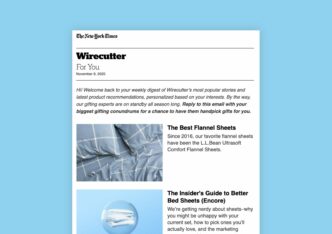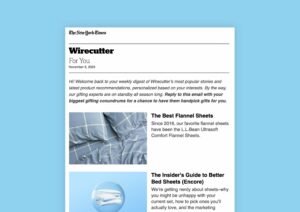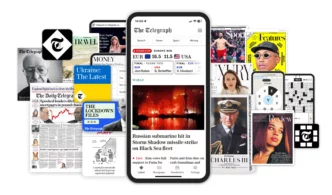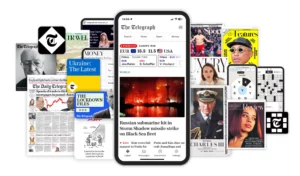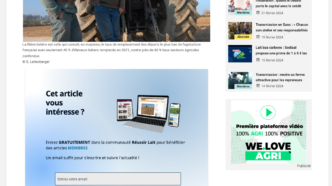
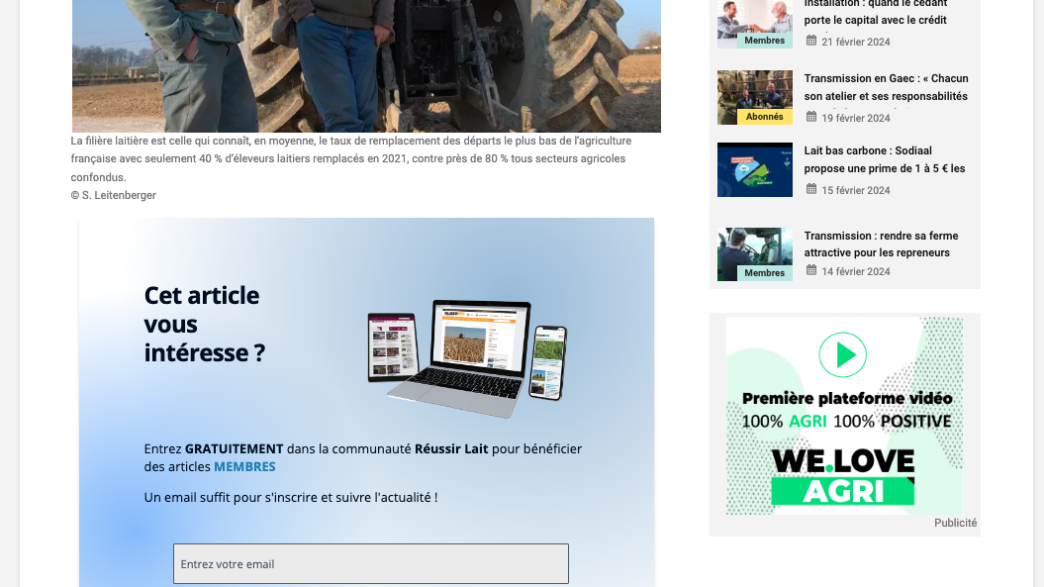
“As soon as readers are logged, engagement increases significantly, and we gain an increasingly detailed customer knowledge base, enabling us to gradually qualify and target registered members, moving them towards subscribing, and push personalized upsell offers to our loyal, long-standing subscribers.”
Yoni Benaim, CDO of Réussir’s group
Réussir is an agricultural press group whose business model, like so many others, was traditionally based on print advertising. Of course, digital ambitions began to emerge in the early 2000s, but it took a pandemic to trigger a digitalization shock, spearheaded by Managing Director, Thibaut De Jaegher, and today orchestrated by Yoni Benaim, Chief Digital Officer. Together, they agreed to take part in this cross-interview project. The idea? To get the big bosses to share the business context and vision behind a major digital project, and for the operational manager to recount how it actually unfolded.
Thibaut, Yoni, bonjour! Can you tell us a bit about the Réussir group?
Thibaut: Our mission is to support agricultural and food industry professionals by providing them with quality, value-added information. Based in Paris, Brussels and Caen (where our head office is located), we’re traditionally print-based. But we’ve transformed over the past few years into a B2B digital press group, with specialized content and digital services.
We’re a team of 110, and our main aim is to provide a service to our readers, to be useful to them in their jobs, particularly thanks to our digital publication.
Yoni: Yes, we had a big digitalization roadmap. We used to be very focused on print advertising, but over the last few years we’ve been trying to put digital subscriptions at the center by developing information services.
My job as Digital & Data Manager is to make life as easy as possible for our users.
How did you get started in this digitalization?
Thibaut: In concrete terms, we launched the Réussir.fr portal in 2020, just before the pandemic, bringing together our 10 B2B universes. I wanted to turn Covid into a digital shock, internally of course, but also in our relationship with our subscribers – we collected almost 30,000 email addresses at the time, for example. And because we were suffering from paper shortages, we offered our subscribers the chance to receive their monthly magazine in digital format by email and via an ereader.
Collecting reader email addresses seems to be very important for your business model…
Yoni: Yes, since 2021 we’ve put all our content behind a registration wall, asking for an email address in exchange for access to articles.
Thibaut: We learned a lot about this subject thanks to the start-up Commoprices, specialized in tracking raw materials, which we bought in 2018 and developed until 2022. Originally, Commoprices required users to log in to test the platform. As a result, all we had to do to convert audiences into subscribers was select qualified leads! So we decided to apply the same strategy to our media titles.
Yoni: What really changed our rhythm was the launch of a dynamic registration wall with Poool at the end of 2022. We used to create around 200 free accounts a month. But as soon as Poool Access was launched, we made incredible progress, peaking at 1,500 accounts created in March 2023, now settling at 700-800 validated accounts per month.
You only ask for an email address. How do you make sure these are real email addresses?
Yoni: To make life easier for the reader, and reduce friction, we only ask for their email address via a form within the wall itself. Completing this form triggers a welcome email which asks the user to click on a link to confirm their account. It’s this number (of ‘validated’ accounts) that I’m sharing with you in the figures above.
In 2023, just under 11,000 validated accounts were created. Around a third of the email addresses deposited in our registration walls are validated. The rest are false addresses, or members who already have accounts and try to login via the registration wall.
How have you implemented this registration wall? Are there some formats that have worked better than others?
Thibaut: When we launched, we wanted to go very fast to get it out before an agricultural conference in February, which is a very strong audience vector for us.
Yoni: To launch with speed, we put up the same wall everywhere, for all ‘premium’ articles, except for a single A/B test where we ask the user for their interests to help us better understand our prospects:
We have 10 titles, each focusing on a particular sector (Cattle, Cereals, Beekeeping, etc.), so knowing which field our prospect is interested in is vital to offering the right subscription and targeting marketing messaging.
Have you also implemented a registration strategy for your free articles?
Yoni: Yes, on free articles, those open to all readers, we ask for registration after 2 or 3 articles. The wall, on the other hand, is non-blocking here with a button saying “I’ll continue reading”.
I’ll add that we’ve integrated a “Members” audience segment for each article type (free and member-only) to unlock all articles, always for registered members.
Why is it important for you to log readers?
Yoni: One word: engagement… As soon as readers are logged in, their article consumption increases significantly. For example…
We see a drastic drop in bounce rate, from 70% for anonymous readers, to 15% when the person is known and logged!
Session durations rise from 1.20 minutes (unlogged) to 7.61 minutes for logged-in users!
In terms of page views, 1.4 PVs/session for anonymous users, and 5.6 PV/session for our members…
It’s easy to see the value of registration!
How has this logged-in audience share evolved at Réussir?
Yoni: At the end of 2022, 4% of page views were from logged-in members. By the end of 2023, we had reached 10%. But we’re not finished yet…
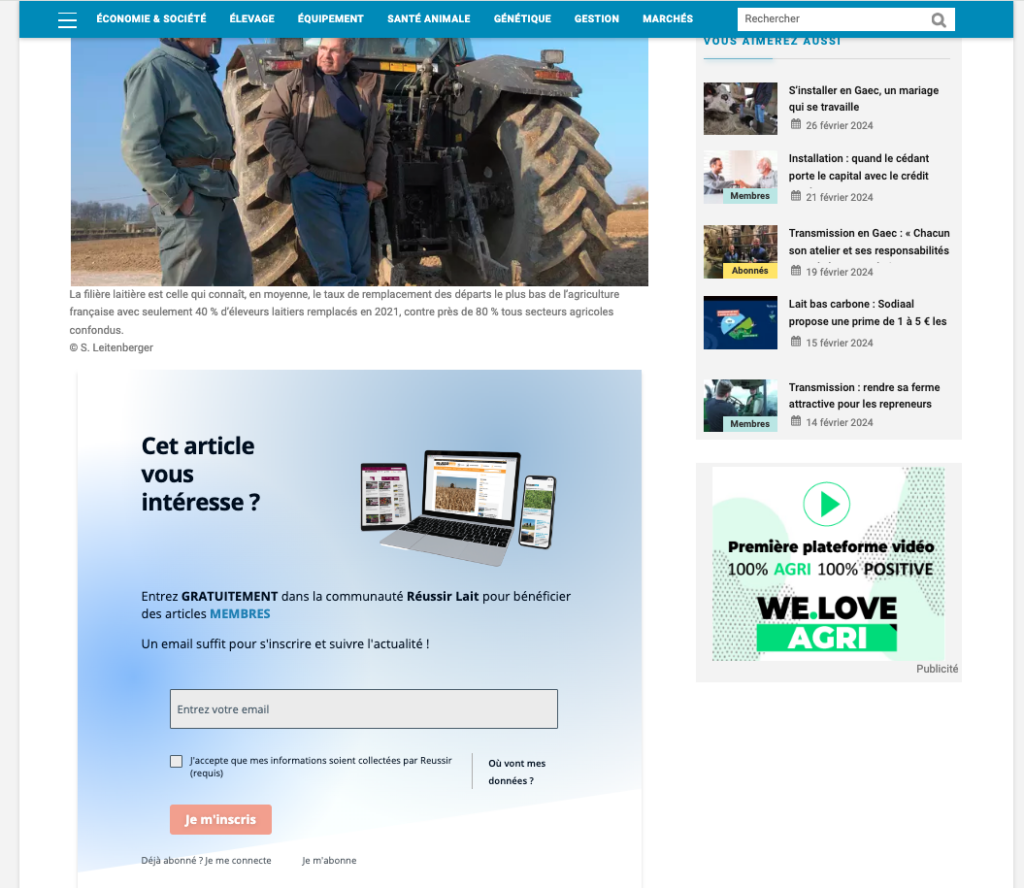
Can you explain how this strategy of building up free members supports paying subscriber acquisition?
Yoni: In concrete terms, when you create an account, you’re automatically signed up to the newsletter linked to that title.
Thibaut: And to get to know our prospects better, we recently bought a direct marketing firm, which had a great deal of information on our target audience, 380,000 French farmers!
Yoni: We then enrich each new member’s profile, comparing it with this company’s database and qualifying those we know fairly quickly (especially those who have changed activity, which is quite common in the farming world!)
We then move on to the conversion funnel, presenting direct marketing actions to promote subscription offers (with discounts such as Black Friday, New Year’s Eve, etc.) and phoning.
Today, we don’t (yet) have a paywall – sales are made after account creation.
How is your paid subscriber growth?
Thibaut: Over the past three years, we’ve been growing and growing. There are fewer and fewer farmers in France, but we’re capturing more and more subscribers! We have two levers for this: the quality of our content, aiming to be useful to farmers, and the increasingly detailed customer knowledge base which enables us to push personalized upsell offers to our loyal, long-standing subscribers.
Yoni: Before we embarked on this digitalization project, 100% of our subscribers were to our print product, or almost. There was a premium newsletter, and subscribers could access the title’s associated website, but the product was print. Today, our portfolio includes 12% digital subscribers. It’s not a lot but we’re closer to where we want to be and our digital offering is developing.
Does collecting all this data about your prospects also feed your advertising strategy?
Yoni: Yes, indeed! Being able to offer targeted display advertising obviously enables us to offer advertisers more qualitative, more effective contexts, which we can sell at a higher price.
Advertisers want finer, more niche targeting. In our market, affinity is very, very important, and it’s part of Réussir’s DNA. We’re not a generalist in the agricultural sector, but we offer very fine-tuned targeting, with operations that can go as far as giving advertisers hot leads that we’ve identified via our content.
The registration wall also enables us to identify consumer habits. For example, a farmer who subscribes to our “Bovins viande” title often ends up on “”Céréaliers pages. Without this knowledge, we wouldn’t have seen this valuable opportunity to increase average revenue, and act on it.
Collecting data is important, but it takes a lot of people to sort and understand it… How do you process the data and make it actionable?
Yoni: We’re in a finite B2B market in the sense that there are 380,000 farmers in France and that’s it. That’s a lot, but not that many either. So the masses remain manageable, and are handled by our 10-strong subscription department.
In terms of tools, we’ve built up a fairly comprehensive BI dashboard which shows the subjects a prospect or subscriber has consulted over a given period, and our key indicator is the number of page views consumed on each subject:
This chart enables us to easily identify individual customer behavior, and seize opportunities to sell or upsell subscriptions. And even avoid churn by tracking any decline in consumption. That’s the whole point of collecting data: to use it effectively to sell additional subscriptions!
When you launched a hard registration strategy, didn’t you fear that you’d lose traffic?
Yoni: Of course, we feared a drop in audience, but in the end nothing happened, not in terms of SEO, nor on the webperf side.
Of course, the debate of blocking articles or not came up internally. So we had to reaffirm to our team where the story was going, the reasoning behind this move and the value of doing it. Ultimately, the goal is to enhance the value of our content and therefore forefront the expertise of our teams!



